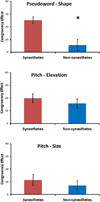Synesthesia strengthens sound-symbolic cross-modal correspondences
- PMID: 27564319
- PMCID: PMC5089906
- DOI: 10.1111/ejn.13381
Synesthesia strengthens sound-symbolic cross-modal correspondences
Abstract
Synesthesia is a phenomenon in which an experience in one domain is accompanied by an involuntary secondary experience in another, unrelated domain; in classical synesthesia, these associations are arbitrary and idiosyncratic. Cross-modal correspondences refer to universal associations between seemingly unrelated sensory features, e.g., auditory pitch and visual size. Some argue that these phenomena form a continuum, with classical synesthesia being an exaggeration of universal cross-modal correspondences, whereas others contend that the two are quite different, since cross-modal correspondences are non-arbitrary, non-idiosyncratic, and do not involve secondary experiences. Here, we used the implicit association test to compare synesthetes' and non-synesthetes' sensitivity to cross-modal correspondences. We tested the associations between auditory pitch and visual elevation, auditory pitch and visual size, and sound-symbolic correspondences between auditory pseudowords and visual shapes. Synesthetes were more sensitive than non-synesthetes to cross-modal correspondences involving sound-symbolic, but not low-level sensory, associations. We conclude that synesthesia heightens universally experienced cross-modal correspondences, but only when these involve sound symbolism. This is only partly consistent with the idea of a continuum between synesthesia and cross-modal correspondences, but accords with the idea that synesthesia is a high-level, post-perceptual phenomenon, with spillover of the abilities of synesthetes into domains outside their synesthesias. To our knowledge, this is the first demonstration that synesthetes, relative to non-synesthetes, experience stronger cross-modal correspondences outside their synesthetic domains.
Keywords: auditory; implicit association test; visual.
© 2016 Federation of European Neuroscience Societies and John Wiley & Sons Ltd.
Figures


Similar articles
-
Sound symbolism in synesthesia: evidence from a lexical-gustatory synesthete.Neurocase. 2014;20(6):640-51. doi: 10.1080/13554794.2013.826693. Epub 2013 Aug 23. Neurocase. 2014. PMID: 23972101
-
Cross-modal, bidirectional priming in grapheme-color synesthesia.Conscious Cogn. 2015 May;33:325-33. doi: 10.1016/j.concog.2015.01.020. Epub 2015 Feb 19. Conscious Cogn. 2015. PMID: 25704552
-
Musical space synesthesia: automatic, explicit and conceptual connections between musical stimuli and space.Conscious Cogn. 2014 Aug;28:17-29. doi: 10.1016/j.concog.2014.06.001. Epub 2014 Jul 12. Conscious Cogn. 2014. PMID: 25023138
-
Crossmodal interactions: lessons from synesthesia.Prog Brain Res. 2006;155:259-71. doi: 10.1016/S0079-6123(06)55015-0. Prog Brain Res. 2006. PMID: 17027393 Review.
-
Auditory synesthesias.Handb Clin Neurol. 2015;129:389-407. doi: 10.1016/B978-0-444-62630-1.00022-6. Handb Clin Neurol. 2015. PMID: 25726281 Review.
Cited by
-
Consistency and strength of grapheme-color associations are separable aspects of synesthetic experience.Conscious Cogn. 2021 May;91:103137. doi: 10.1016/j.concog.2021.103137. Epub 2021 Apr 29. Conscious Cogn. 2021. PMID: 33933880 Free PMC article.
-
Neural basis of the crossmodal correspondence between auditory pitch and visuospatial elevation.Neuropsychologia. 2018 Apr;112:19-30. doi: 10.1016/j.neuropsychologia.2018.02.029. Epub 2018 Mar 1. Neuropsychologia. 2018. PMID: 29501792 Free PMC article.
-
Neural Basis of the Sound-Symbolic Crossmodal Correspondence Between Auditory Pseudowords and Visual Shapes.Multisens Res. 2021 Aug 11;35(1):29-78. doi: 10.1163/22134808-bja10060. Multisens Res. 2021. PMID: 34384048 Free PMC article.
-
Interactions Between Auditory Elevation, Auditory Pitch and Visual Elevation During Multisensory Perception.Multisens Res. 2017 Jan 1;30(3-5):287-306. doi: 10.1163/22134808-00002553. Multisens Res. 2017. PMID: 31287081 Free PMC article.
-
Stimulus Parameters Underlying Sound-Symbolic Mapping of Auditory Pseudowords to Visual Shapes.Cogn Sci. 2020 Sep;44(9):e12883. doi: 10.1111/cogs.12883. Cogn Sci. 2020. PMID: 32909637 Free PMC article.
References
-
- Audacity Team. Audacity v2.0.1 [Computer program] 2012 Retrieved from http://audacity.sourceforge.net/ Audacity ® software is copyright © 1999–2014 Audacity Team.
-
- Ben-Artzi E, Marks LE. Visual-auditory interaction in speeded classification: role of stimulus difference. Percept Psychophys. 1995;57:1151–1162. - PubMed
-
- Bargary G, Mitchell KJ. Synesthesia and cortical connectivity. Trends Neurosci. 2008;31:335–342. - PubMed
-
- Barnett KJ, Finucane C, Asher JE, Bargary G, et al. Familial patterns and the origins of individual differences in synesthesia. Cognition. 2008;106:871–893. - PubMed
MeSH terms
Grants and funding
LinkOut - more resources
Full Text Sources
Other Literature Sources
Molecular Biology Databases

